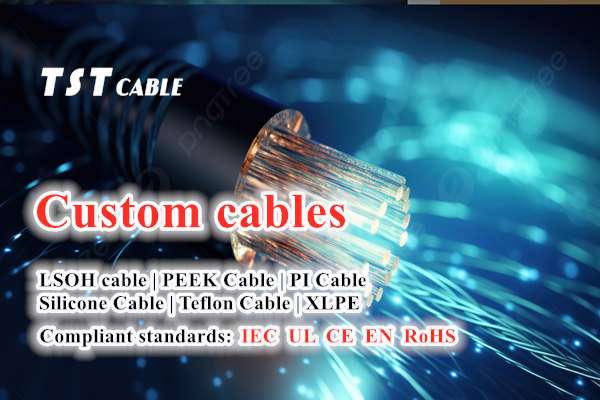
Wiring Adaptability
To meet the specific requirements of equipment wiring, the cable offers customized solutions to avoid performance loss caused by improper wiring:
Tensile Strength Requirements: Nickel-plated copper alloy conductors offer 30% higher tensile strength than pure copper conductors, adapting to the vibration and stretching experienced during spacecraft launches and preventing conductor breakage.
Lightweight and Space-Saving Requirements: A lightweight cable version is available, featuring fine-diameter nickel-plated copper strands twisted together. This reduces weight by 20% compared to conventional cables and can be installed in the narrow wiring compartments of equipment, saving installation space.
Electromagnetic Interference Protection: Shielded cables feature a nickel-plated copper core and braided shield with a shielding effectiveness of 80dB (100MHz band), blocking electromagnetic radiation from radar and navigation systems, ensuring distortion-free transmission of instrument signals.
- Product Architecture: The “Dual Empowerment” of Materials and Structure
The superior performance of 260°C-grade PTFE single-core/multi-core cables stems from innovative materials and structural optimization across the entire chain: conductor, insulation, shield, and jacket. Each design layer addresses the core challenges of extreme environments: - Conductor: The “Basic Guarantee” of Conductivity and Heat Resistance
Nickel-plated copper or nickel-plated copper alloy is used as the conductor material:
It resists oxidative corrosion at temperatures up to 260°C, preventing the formation of an oxide layer on the conductor surface that increases contact resistance.
Pure nickel-plated copper conductors are suitable for general use and offer excellent conductivity. Nickel-plated copper alloy conductors are designed for tensile strength, maintaining conductivity while improving mechanical strength to withstand harsh operating conditions such as vibration and tension.
02 Insulation: An “Electrical Barrier” for High Temperatures
The insulation layer utilizes polytetrafluoroethylene (PTFE), a material considered the “king of insulation for extreme environments.”
High-Temperature Resistance: PTFE has a long-term operating temperature of 260°C and can withstand short-term temperatures of 300°C. It maintains stable insulation performance in high-temperature areas such as spacecraft engine compartments and near ship chimneys.
Chemical Resistance: PTFE is non-corrosive to aviation kerosene, diesel, seawater, hydrochloric acid (5% concentration), and sodium hydroxide (10% concentration). The insulation layer is less susceptible to aging and cracking on ship decks and in field deployments.
03 Shielding: An “Armor” Against Electromagnetic Interference
Shielded cables utilize a nickel-plated copper core braided structure.
This creates a tight electromagnetic shielding network, effectively shielding against high-frequency electromagnetic radiation, preventing electromagnetic signals from radar and communications equipment from interfering with instrument circuits.
The nickel plating not only enhances the shield’s corrosion resistance but also reduces signal loss within the shield, ensuring the integrity of high-frequency instrument signal transmission.
- Jacket: The “Last Line of Defense” Against the External Environment
The jacket is made of fusible polytetrafluoroethylene (PFA), which combines protection and process adaptability:
Heat and Corrosion Resistance: PFA has a long-term operating temperature of up to 260°C, with chemical resistance comparable to PTFE. It also offers excellent abrasion resistance, protecting against mechanical friction during equipment operation.
Process Advantages: PFA can be melt-extruded, resulting in a smooth jacket surface and high dimensional accuracy, facilitating wiring in confined spaces. It also bonds tightly to the insulation layer, preventing delamination or shedding.
- Core Advantages: Four Key Features Ensure “Reliability in Extreme Environments”
The 260°C-grade PTFE single-core/multi-core cables are suitable for high-end equipment applications due to their four core advantages over traditional cables:
- “Extremely Stable” Electrical Performance: The high insulation resistance and low dielectric loss of the PTFE insulation layer ensure stable electrical performance at temperatures as high as 260°C and as low as -65°C. 2. Chemical Resistance: Comprehensive Coverage
From aviation fuel and hydraulic oil to seawater and acidic and alkaline solvents, the cable’s PTFE insulation and PFA jacket resist a wide range of chemical media. - Flame Retardancy: Safe and Reliable
The cable has passed the UL94 V0 flame retardancy test – burning vertically will self-extinguish within 10 seconds, with no dripping igniting the cotton underneath, effectively preventing the spread of flame. - Service Life: Long-Lasting Durability
The cable has passed the UL94 V0 flame retardancy test – burning vertically will self-extinguish within 10 seconds, with no dripping igniting the cotton underneath, effectively preventing the spread of flame.
Conclusion: Empowering the “Neural Networks” of High-End Equipment with Material Innovation
The value of 260°C-grade PTFE single-core/multi-core cables lies not only in their temperature resistance range of -65°C to 260°C and UL94 V0-rated flame retardancy, but also in their precise material selection and scenario-based structural design, which address the industry pain point of “unreliable line connections in extreme environments” for high-end equipment such as aerospace, weapons, and ships. As the requirements for environmental adaptability and operational reliability in high-end equipment continue to increase, these specialty cables will continue to be upgraded, further empowering the “neural networks” of high-end equipment and providing solid line support for the development of China’s national defense and aerospace industries.
Also available in:
English

